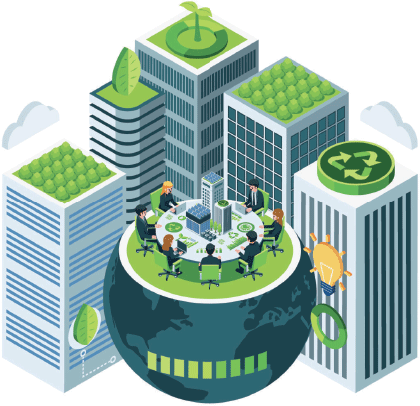
Karachi’s population has crossed 20 million people, indicating the economic promise and perilous byproducts of the ambition to cash it. However, in these trials of the city’s resilience lies the immense potential for Karachi to become a model of regenerative urbanism.
Regenerative infrastructure design
Metropolitan cities must actively regenerate ecosystems disturbed through infrastructure design for long-term sustainability. For Karachi, this could mean adapting the urban environment to restore biodiversity, manage heat, and mitigate floods.
Examples include the treatment of industrial runoff and the construction of wetlands in Malir and Korangi, due to their proximity to waterways. Green corridors can be connected to urban public spaces, such as Karachi University, Safari Park, and the Malir River, to form a biodiversity belt. Using permeable paving in all public spaces could help restore aquifers and groundwater.
Greener mobility
A mobility system that prioritises people instead of vehicles is needed. Currently, private vehicles and unregulated transport rule the roads. With a poor ranking on the air quality index and extended summers, sustainable transport options like bicycles are wishful rather than practical.
Building greener, people-centric infrastructure in Karachi is possible through a range of micro and macro projects
We need pedestrian infrastructure in all major markets of the city with strict monitoring to prevent encroachments, already seen in Bohra Bazaar and Burns Road. These are isolated projects with no consideration of parking or walkways from the parking to the markets.
Shaded walkways between amenities and the market should be designed to discourage encroachments, lined with green pockets, water fountains, and mist stations.
Small solar-charged vehicles, such as e-rickshaws, e-scooters, and mini electric vans, can be used to facilitate such projects. These can also be run in campus zones such as Karachi University, NED University, or congested old town areas.
On-demand, app-based electric shuttles with dynamic routing algorithms, operating in cities like Nairobi or Jakarta, can help achieve last-mile connectivity from metro/Bus Rapid Transit (BRT) stops to homes and offices, especially in low-income neighbourhoods.
Transit-oriented development (TOD) zones surrounding the Green Line BRT and Karachi Circular Railway can include affordable housing and mixed-use buildings by rezoning land within 500-800 meters of major stations, such as Nagan Chowrangi, Orangi, Landhi, and Korangi. Low-income housing units (with social rent schemes) can be integrated into new developments to avoid gentrification.
Green public plazas, rather than concrete/paved spaces, should be used in front of malls, food streets, or even major stations. For example, the paved drop-off in front of Dolmen Mall at Seaview can be converted into a green urban space, or the space around Numaish Station can be transformed into a linear, shaded park plaza that benefits vendors and commuters. These places can also be used to host social events.
For neighbourhoods, tree canopies, solar roofs, misting fans, and designed kiosks are physical interventions that create walkable green loops with community participation, linking key spaces in an area, such as schools, clinics, neighbourhood markets, and bus stops.
Creation of small-scale economic zones around key industrial hubs (Lyari, SITE, Malir Halt) for micro-enterprise incubation, street markets, and community spaces could also be an option to boost the city’s sustainability initiatives and provide employment at the grassroots.
TOD zones can also act as decentralised utility hubs, including mini solar grids, solid waste sorting centres, and rainwater harvesting systems, which reduce the load on central systems.
Reclaiming public space
Karachi Metropolitan Corporation has restored spaces like Frere Hall, Jahangir Park, and Nishtar Park as inclusive civic hubs. Careful preservation of these spaces always enhances female/family mobility, sensitively addressing the need for safety through monitored access. Street vending should be enabled through designated spots for informal workers, encouraging female hawkers.
Environmental safety through policy and legislation:
Mandatory green walls and roofs in commercial buildings, offering tax benefits for areas with mixed businesses, especially in congested areas like Saddar and II Chundrigarh Road, is another option that can be considered, along with pocket parks in dense neighbourhoods and green sidewalks in residential neighbourhoods. The idea is to cross-subsidise such developments to solve the issue of funding, and including the people will help in maintenance.
While there are many ideas to make Karachi more habitable, the friction between bureaucratic agencies, such as SBCA, KMC, cantonment boards, and federal bodies, paralyses governance through fragmentation. In the short term, profit-driven construction, speculative real estate development, and politically backed land grabbing result in the loss of long-term projects that offer environmental and social benefits.
The political symbolism is evident in the large appreciation boards placed outside such projects, thanking those who have already been compensated for their work.
Karachi desperately needs transparent budgeting, participatory planning, and gender inclusion, as well as anti-corruption mechanisms and independent watchdogs for environmental compliance laws. Without the above being premeditated within the system, even the best of green design strategies will fail.
The writer is an architect and urban planner, currently leading her own practice, “Beyond Facades”
Published in Dawn, The Business and Finance Weekly, September 1st, 2025

